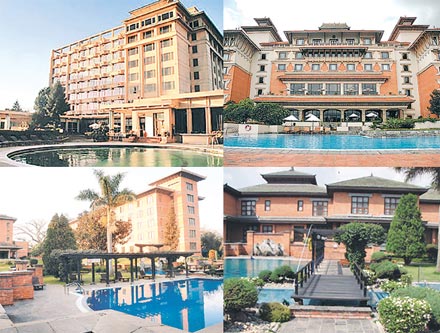

5-star hotels upbeat over advance booking trends

Hoteliers have reported a gradual rise in advance bookings for April-May and expect March to end with an average occupancy of 75 percent due to positive political developments following the November election.
They have projected a busy spring season (March-May) with an increase in the number of leisure and adventure travellers.
However, hotel owners said they had two worries hanging over their heads. One, staggered elections in India scheduled for April-May that may affect Nepal’s tourism; and two, declining room rates which currently range between US$ 80 to US$ 90.
The March-May period in Nepal is the best season for trekking and mountaineering as it offers excellent weather conditions with hardly any rain and is considered to be the second peak season after the autumn season (September-November).
“We expect to close March at 75 percent occupancy, while we have received 60 percent reservations for April,” said Raj Bikram Shah, sales and marketing director of the Hotel Annapurna.
Hotel occupancy and bookings have been good despite issues like the European Commission’s ban on Nepali airlines and constant glitches at the country’s sole air gateway Tribhuvan International Airport in Kathmandu.
Shah said that the phase-wise general election in India could affect the movement of Indian as well as other travellers to Nepal. As Nepal does not have direct
connectivity to many long-haul markets, 30-35 percent of the arrivals to the country come through India.
“However, we can consider that after a slowdown in growth in tourist arrivals since November last year, the industry is back on track,” added Shah.
Meanwhile, Kaushal Kumar Singh, sales and marketing director of the Hotel Everest, said that his hotel was likely to close March with 80 percent occupancy and that bookings for April had crossed 60 percent.
“Occupancy is so far good, but not good in terms of revenue,” he said. Emerging destinations like Vietnam, Myanmar, Sri Lanka and Kazakhstan have been attracting tourists in a big way, and it will be difficult for Nepal to compete with their diverse and abundant attractions and low-price packages, he added. “We need strenuous marketing efforts to increase business in the coming days.”
Travel trade entrepreneurs said that talks on increased investment commitments from donor communities and Nepal’s being publicized by travel magazines as one of the hottest destinations in 2014 have sent positive vibes across destinations resulting in tourist traffic. The election last year had led to a flood of cancellations, but things are returning to normal, said Annal Kumar Pradhan, public relation executive at the Hotel Hyatt Regency Kathmandu. “Despite various factors affecting the country’s tourism growth and slowed occupancy in February, we are pleased that demand has picked up in March,” Pradhan said.
Similarly, the Hotel Yak & Yeti said that it expected its occupancy in March to touch 80 percent while it has received 65 percent confirmed bookings for April. Hoteliers said that the European Commission’s travel advisory not to fly Nepali airlines had not affected European arrivals much.
Five-star hotels in Nepal recorded an average room occupancy rate of 62.16 percent in 2012, up 0.53 percent. According to the Tourism Ministry, five-star properties in Kathmandu recorded an average occupancy of 75.45 percent in March. The figures for April and May were 73.37 percent and 57.57 percent respectively last year. The 10 five-star hotels in Nepal produce 643,428 room nights.
source: the kathmandu post,28 march 2014








